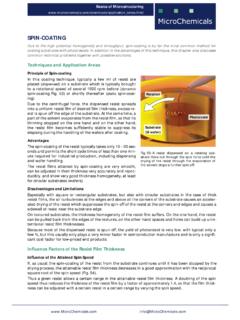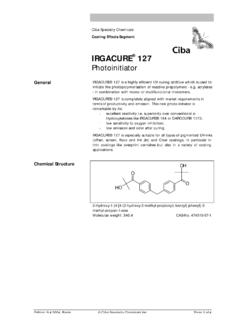Transcription of Exposure of Photoresists - MicroChemicals
1 Chapter01 MicroChemicals Fundamentals of of EXPOSUREThe previous chapters have described the steps and which are necessary to provide a substrate with an expos-able resist coating. As the name photolithography already clearly expresses, the following Exposure of photore-sists represents the main key process in chemical processes occurring here in the resist fi lm result in an increased (positive resists) or reduced (neg-ative resists) solubility in the developer, whereby a structured resist mask can be chapter enters into detail on all aspects of Exposure : From the chemical and physical processes in the resist fi lm, the spectral sensitivities of Photoresists and the spectral emissions and properties of common Exposure methods through application-oriented explanations with focus on an optimally exposed resist fi lm. The PhotoreactionDNQ-based Positive and Image Reversal ResistsThe schema in Fig.
2 82 shows the essential steps of the photoreaction, the desired chemical reaction during the Exposure of the photoinitiator in the photoresist : Under nitrogen release and the binding of water molecules, the photoinitiator molecule is converted into an indene carboxylic binding site of the SO2-R group determines whether a photoresist is h- and i-line sensitive (binding site on the "right" carbon ring) or g-line (binding site on the "left" carbon ring). In order to increase their thermal stability and solubility in the resist as well as to strengthen the properties as an "inhibitor" (re-duced dark erosion), several DNQ sulphonate molecules can be bound to a so-called backbone quantum effi ciency of the photoreaction defi nes the number of photoreactions per photons ab-sorbed in the resist fi lm. Suffi ciently rehydrated DNQ-based Photoresists with transparent resin, exposed at suitable wavelengths (g, h, i-line depending on DNQ), achieve a quantum effi ciency of approx.
3 20 - 30%.If a minimum amount of water is missing in the resist fi lm (insuffi cient rehydration, see Chapter 14), the ketone (Fig. 82 centre) may undergo various undesired secondary reactions ( esterifi cation with the resin or polymerisation with CO2 splitting). In both cases, no indene carboxylic acid is formed, the rate of development increases exclusively through the decrease in the concentration of the inhibitor Positive ResistsIn the case of special chemically amplifi ed resists such as the AZ 40 XT, no indene carboxylic acid but rather sulphonic acid is formed during Exposure . Neither water is chemically bound nor N2 released, which makes the processing of this resist much easier and faster even with very large resist fi lm thick-nesses than would be possible with DNQ-based Negative ResistsIn some negative resists such as the AZ nLOF 2000 series or the AZ 15 nXT, the Exposure activates a melamine cross-linker which in the subsequent baking step (post- Exposure bake) causes the linking of short phenolic resin units to longer the AZ 125 nXT, the Exposure starts a photo polymerisation of acrylic monomers already at room temperature.
4 This resist does not require a post Exposure Sensitivity of PhotoresistsFig. 82: The photoinitiator, a diazo-naphthoquinone (DNQ) sulphonate (left) is converted into an indene carboxylic acid (right) under N2 release (cen-tre) and H2O absorption by Exposure to suitable Chapter01 MicroChemicals Fundamentals of of , H- and I-line Sensitive PhotoresistsThe spectral sensitivity of the AZ and TI Photoresists we sell is in the near-UV range, and with most re-sists, also in the visible short-wavelength (blue) spectral which are only sensitive in the range of the i-line (365 nm) are called i-line resists. These include, among others, chemically-amplifi ed positive resists such as the AZ 40 XT or negative resists such as the AZ 15 nXT, AZ 125 nXT or the AZ nLOF 2000 series. Broadband resists also absorb the g- (435 nm) and h- (405 nm) lines, but can also be exposed monochromatically within their spectral ResistsDeep-UV resists have a spectral sensitivity below 280 nm wavelength.
5 Through Exposure wavelengths of, for example, 247 or 193 nm, the resolution of attained resist structures can be improved signifi cantly compared with i-line or broadband resists. Combined with the so-called immersion lithography, structure sizes under 50 nm are Generation PhotoresistsTo meet the requirement of smaller and smaller structure sizes, Photoresists which can be exposed at even shorter wavelengths are required. However, the transition to the so-called extreme UV (EUV) radia-tion (< 120 nm wavelength) and X-ray lithography (< 10 nm) requires completely diff erent optical systems and materials than the currently mainly used photolithography TechniquesMask AlignersWith Exposure using a mask aligner, parallel light passes through the transparent areas of a photo mask onto the resist fi lm (Fig. 83 left). The photo mask usually consists of a glass or quartz plate as carrier on which a thin lithographically patterned chromium coating forms the non-transparent dimensions of the structures on the photo mask correspond to 1 : 1 the dimensions of the exposed areas of the resist fi lm, the image is thus an optimisation of the attained resolution, the photo mask and the surface of the resist fi lm are in direct contact, whereas, for example, textured substrates may require a gap between the mask and the resist fi a stepper, Exposure is also performed as a projection through a photo mask (Fig.)
6 83 centre). By reduction optics, the dimensions of the exposed resist areas are, however, smaller than the structures of the photo mask on which lower requirements can be 83: The most common methods for Exposure of photoresist layers are the direct projection onto the whole substrate with a mask aligner (left, usually the photomask and resist are in close contact), the stepwise Exposure of rectangular par-tial surfaces by a reduction optics (stepper, centre) or the direct writing of the structures with a laser (right).OpticsParallel lightSubstrateSubstrateLaser beamPhoto maskPhotoresistalready exposedPhotoresist Chapter01 MicroChemicals Fundamentals of of only a part of the resist fi lm is exposed by the reduced image during each Exposure step, the expo-sure of the entire wafer takes place step by step in sequence always having the same image, whereby, for example, a large number of identical circuits or components are realised on one Direct WritingIn this case, a laser sequentially exposes the photoresist fi lm on a direct path (Fig.
7 83 right), pixel by pixel. This eliminates the need for the production of expensive photo masks. Layouts can be implemented immediately if they are available in a suitable electronic form to the laser Exposure tool. One drawback of the laser Exposure is the long writing times per substrate, which is why this Exposure technology then lends itself if a layout is only to be written on a few substrates as is the case in the production of photo treats the laser Exposure from the perspective of photoresist processing in Exposure TechniquesIn order to implement high resolution requirements, reproducible structure and defi ned resist sidewalls, Exposure wavelengths adapted to the absorption of the resist, as well as perfect optics, such as off ered with mask aligners, steppers or laser exposures, are neither corresponding equipment is available, nor high demands by means of resolution made on the attained resist mask, an Exposure can also be done via, for example, printed foil masks over any other light sources with a suitable spectrum.
8 For example, the emission spectrum of white fl uorescent tubes with the blue g-line (435 nm wavelength) strongly represented, allows the Exposure of standard broad-band resist in a rather simple Emission of Typical Exposure ToolsMercury Vapour LampsThe typical emission spectrum of a mask aligner or stepper with mercury vapour lamp without further optically selective elements contains the g- (wavelength 435 nm), h- (405 nm) and i-line (365 nm). A 6 mask aligner with a 350 W Hg lamp usually attains a light output of approx. 15 - 30 mW/cm2, whereby the i-line intensity usually accounts for approx. 40% of the total emission of all three emission lines. The ab-sorption spectrum of the photoinitiator of corresponding Photoresists is adapted to these for dose-sensitive applications such as image reversal resist, thick-resist processing or for high resolution requirements, a periodic calibration of the light intensity is recommended, which changes with the operating time of the lamp.
9 As a rule of thumb for non-critical litho-processes, a measurement of the lateral intensity distribution over the illuminated area should yield less than 10% relative deviation to allow the adjustment of an optimal Exposure time for central and peripheral ExposureIn addition to Hg lamps, lasers with a suitable wavelength are also a suitable light source for the Exposure of Photoresists . Because the spectral absorption bands of the photoinitiator do not abruptly terminate at a particular wavelength, a correspondingly adapted dose can also be exposed at wavelengths of some 10 nm above the ranges indicated in the data sheets, which, however, signifi cantly extends the writing times. Determination of Optimum Exposure Dose and Exposure DurationConversion Factors between Exposure Dose and Exposure DurationFor the correct determination of the Exposure time from the recommended Exposure doses given in the technical data sheets, the following must be known: What is the spectrum of the Exposure tool (monochromatic at i-, h- or g-line or broadband across all lines)?
10 Without optically selective elements such as i-line fi lters, all three lines are usually present in Hg vapour lamps. At which wavelength was the light intensity determined? Many detectors measure only i-line, which typi-cal 350 W Hg lamps emit with approx. 6 - 12 mW / cm2, with 1000 W Hg lamps about three times higher. At which wavelengths is the photoresist sensitive (i-, h- or / and g-line), and how sensitive? Chapter01 MicroChemicals Fundamentals of of To which wavelength corresponds the light dose in the technical data sheets of the Photoresists ? Usu-ally, the Exposure series shown there are performed with monochromatic i-line of Exposure Intensity and Exposure TimeThe photoreaction with positive and image reversal resists usually is a one-photon process. For this rea-son, it does not matter in principle how much time (from femtoseconds in pulsed lasers, to seconds in contact lithography to hours in laser interference lithography) the required dose is applied onto the resist fi lm as a product of intensity and , it must be taken into account that the delayed discharge of the heat or gases formed during Exposure (N2 in the case of positive and image reversal resists) from the resist fi lm can lead to thermal or mechanical damage to the resist with increasing light intensity and resist fi lm Infl uencing Factors on the Optimal Exposure DoseThe refl ectivity of the substrate has an eff ect on the Exposure intensity actually absorbed by the resist fi lm, particularly in the case of optically thin resist fi lms.








